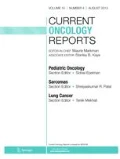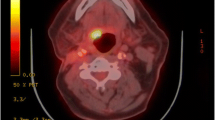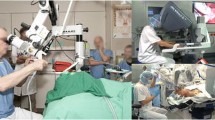Abstract
The incidence of oropharyngeal squamous cell carcinoma (OPSCC) is increasing in the USA despite a decline in traditional risk factors. This trend is attributed to human papillomavirus (HPV)-associated malignancies and is particularly notable in a younger patient demographic with fewer comorbid diseases and longer life expectancies. Therefore, both oncologic and functional outcomes are important to consider when managing OPSCC in the modern era. The historical management of OPSCC was typically surgical, but traditional open approaches resulted in significant morbidity. As the paradigm shifted, organ-preserving treatment regimens, namely, radiotherapy (RT) and chemoradiation (CRT), replaced surgery as the primary treatment modality. However, these treatment strategies are not without risk of significant sequelae and functional impairment. Transoral robotic surgery (TORS) is a minimally invasive surgical approach that offers surgical access to the oropharynx without the morbidity of open procedures while achieving excellent oncologic and functional outcomes. The appropriate application of this new technology is still being investigated but the current literature supports TORS as a viable option in the management of OPSCC.
Similar content being viewed by others
References
Papers of particular interest, published recently, have been highlighted as: • Of importance •• Of major importance
Siegel R, Ma J, Zou Z, Jemal A. Cancer statistics, 2014. CA Cancer J Clin. 2014;64(1):9–29.
Stein AP, Saha S, Yu M, Kimple RJ, Lambert PF. Prevalence of human papillomavirus in oropharyngeal squamous cell carcinoma in the united states across time. Chem Res Toxicol. 2014;27(4):462–9.
Chaturvedi AK, Engels EA, Anderson WF, Gillison ML. Incidence trends for human papillomavirus-related and -unrelated oral squamous cell carcinomas in the United States. J Clin Oncol. 2008;26(4):612–9.
Panwar A, Batra R, Lydiatt WM, Ganti AK. Human papilloma virus positive oropharyngeal squamous cell carcinoma: a growing epidemic. Cancer Treat Rev. 2014;40(2):215–9.
Pytynia KB, Dahlstrom KR, Sturgis EM. Epidemiology of HPV-associated oropharyngeal cancer. Oral Oncol. 2014;50(5):380–6.
Gayar OH, Ruterbusch JJ, Elshaikh M, Cote M, Ghanem T, Hall F, et al. Oropharyngeal carcinoma in young adults: an alarming national trend. Otolaryngol Head Neck Surg. 2014;150(4):594–601.
Benson E, Li R, Eisele D, Fakhry C. The clinical impact of HPV tumor status upon head and neck squamous cell carcinomas. Oral Oncol. 2014;50(6):565–74.
Ang KK, Harris J, Wheeler R, Weber R, Rosenthal DI, Nguyen-Tan PF, et al. Human papillomavirus and survival of patients with oropharyngeal cancer. N Engl J Med. 2010;363(1):24–35.
Brickman D, Gross ND. Robotic approaches to the pharynx: tonsil cancer. Otolaryngol Clin North Am. 2014;47(3):359–72.
Pfister DG, Harrison LB, Strong EW, Shah JP, Spiro RW, Kraus DH, et al. Organ-function preservation in advanced oropharynx cancer: results with induction chemotherapy and radiation. J Clin Oncol. 1995;13(3):671–80.
Wendt TG. Hazards and risks in oncology: radiation oncology. GMS Curr Top Otorhinolaryngol Head Neck Surg. 2013;12:Doc03.
Forastiere AA, Goepfert H, Maor M, Pajak TF, Weber R, Morrison W, et al. Concurrent chemotherapy and radiotherapy for organ preservation in advanced laryngeal cancer. N Engl J Med. 2003 11/27; 2014/08;349(22):2091-8.
Steiner W, Fierek O, Ambrosch P, Hommerich CP, Kron M. Transoral laser microsurgery for squamous cell carcinoma of the base of the tongue. Arch Otolaryngol Head Neck Surg. 2003;129(1):36–43.
Clayburgh DR, Gross N. Surgical innovations. Otolaryngol Clin North Am. 2013;46(4):615–28.
Moore EJ, Hinni ML. Critical review: transoral laser microsurgery and robotic-assisted surgery for oropharynx cancer including human papillomavirus–related cancer. Int J Radiat Oncol*Biol*Phys. 2013 4/1;85(5):1163-7.
Hockstein NG, Nolan JP, O’Malley BW, Woo YJ. Robotic microlaryngeal surgery: a technical feasibility study using the daVinci surgical robot and an airway mannequin. Laryngoscope. 2005;115(5):780–5.
O’Malley Jr BW, Weinstein GS, Hockstein NG. Transoral robotic surgery (TORS): glottic microsurgery in a canine model. J Voice. 2006;20(2):263–8.
O’Malley BW, Weinstein GS, Snyder W, Hockstein NG. Transoral robotic surgery (TORS) for base of tongue neoplasms. Laryngoscope. 2006;116(8):1465–72.
Weinstein GS, Quon H, O’Malley BW, Kim GG, Cohen MA. Selective neck dissection and deintensified postoperative radiation and chemotherapy for oropharyngeal cancer: a subset analysis of the University of Pennsylvania transoral robotic surgery trial. Laryngoscope. 2010;120(9):1749–55.
Weinstein GS, O’Malley Jr BW, Cohen MA, Quon H. Transoral robotic surgery for advanced oropharyngeal carcinoma. Arch Otolaryngol Head Neck Surg. 2010;136(11):1079–85.
Weinstein GS, O’Malley Jr BW, Snyder W, Sherman E, Quon H. Transoral robotic surgery: radical tonsillectomy. Archiv Otolaryngol Head Neck Surg. 2007;133(12):1220–6.
Gunn GB, Debnam JM, Fuller CD, Morrison WH, Frank SJ, Beadle BM, et al. The impact of radiographic retropharyngeal adenopathy in oropharyngeal cancer. Cancer. 2013;119(17):3162–9.
Dirix P, Nuyts S, Bussels B, Hermans R, Van den Bogaert W. Prognostic influence of retropharyngeal lymph node metastasis in squamous cell carcinoma of the oropharynx. Int J Radiat Oncol*Biol*Phys. 2006 7/1;65(3):739-44.
Byeon HK, Duvvuri U, Kim WS, Park YM, Hong HJ, Koh YW, et al. Transoral robotic retropharyngeal lymph node dissection with or without lateral oropharyngectomy. J Craniofac Surg. 2013;24(4):1156–61.
Moore MW, Jantharapattana K, Williams MD, Grant DG, Selber JC, Holsinger FC. Retropharyngeal lymphadenectomy with transoral robotic surgery for papillary thyroid cancer. J Robotic Surg. 2011;5:221–6.
Abuzeid WM, Bradford CR, Divi V. Transoral robotic biopsy of the tongue base: a novel paradigm in the evaluation of unknown primary tumors of the head and neck. Head Neck. 2013;35(4):E126–30.
Mehta V, Johnson P, Tassler A, Kim S, Ferris RL, Nance M, et al. A new paradigm for the diagnosis and management of unknown primary tumors of the head and neck: a role for transoral robotic surgery. Laryngoscope. 2013;123(1):146–51.
Patel SA, Magnuson J, Holsinger F, et al. Robotic surgery for primary head and neck squamous cell carcinoma of unknown site. JAMA Otolaryngol Head Neck Surg. 2013;139(11):1203–11. Retrospective, multi-institution case series that evaluated the utility of TORS for the work-up of an unknown primary tumor site. 47 patients were included and the primary tumor was identified by TORS 72.3% of the time. The primary site was in the base of tongue 58.8% of the time and was located in the palatine tonsil 38.2% of the time. The authors discuss the benefit of being able to simultaneously diagnose and treat an unknown primary using TORS.
Cianchetti M, Mancuso AA, Amdur RJ, Werning JW, Kirwan J, Morris CG, et al. Diagnostic evaluation of squamous cell carcinoma metastatic to cervical lymph nodes from an unknown head and neck primary site. Laryngoscope. 2009;119(12):2348–54.
Ford SE, Brandwein-Gensler M, Carroll WR, Rosenthal EL, Magnuson JS. Transoral robotic versus open surgical approaches to oropharyngeal squamous cell carcinoma by human papillomavirus status. Otolaryngol Head Neck Surg. 2014. Retrospective review evaluating 130 patients with OPSCC treated at UAB with either an open approach or TORS plus adjuvant therapies as indicated. The data demonstrated no sacrifice of oncologic results regardless of HPV status.
Lawson JD, Otto K, Chen A, Shin DM, Davis L, Johnstone PA. Concurrent platinum-based chemotherapy and simultaneous modulated accelerated radiation therapy for locally advanced squamous cell carcinoma of the tongue base. Head Neck. 2008;30(3):327–35.
de Arruda FF, Puri DR, Zhung J, Narayana A, Wolden S, Hunt M, et al. Intensity-modulated radiation therapy for the treatment of oropharyngeal carcinoma: the Memorial Sloan-Kettering Cancer Center experience. Int J Radiat Oncol Biol Phys. 2006;64(2):363–73.
Weinstein GS, Quon H, Newman H, et al. Transoral robotic surgery alone for oropharyngeal cancer: an analysis of local control. Archiv Otolaryngol Head Neck Surg. 2012;138(7):628–34. A prospective observational study of 30 patients treated at Penn with TORS alone demonstrated excellent local control after obtaining negative surgical margins. Mean follow-up was 2.7 years (range, 1.5-5.1 years) and local failure occurred in one patient (3%). This study provides further evidence supporting the possibility of de-intensifying adjuvant therapies.
Hurtuk A, Agrawal A, Old M, Teknos TN, Ozer E. Outcomes of transoral robotic surgery: a preliminary clinical experience. Otolaryngol Head Neck Surg. 2011;145(2):248–53.
Iseli TA, Kulbersh BD, Iseli CE, Carroll WR, Rosenthal EL, Magnuson JS. Functional outcomes after transoral robotic surgery for head and neck cancer. Otolaryngol Head Neck Surg. 2009;141(2):166–71.
Al-Khudari S, Bendix S, Lindholm J, Simmerman E, Hall F, Ghanem T. Gastrostomy tube use after transoral robotic surgery for oropharyngeal cancer. ISRN Otolaryngol. 2013;2013:190364.
Chen AY, Frankowski R, Bishop-Leone J, et al. The development and validation of a dysphagia-specific quality-of-life questionnaire for patients with head and neck cancer: the M. D. Anderson Dysphagia Inventory. Arch Otolaryngol Head Neck Surg. 2001;127(7):870–6.
Sinclair CF, McColloch NL, Carroll WR, Rosenthal EL, Desmond RA, Magnuson J. Patient-perceived and objective functional outcomes following transoral robotic surgery for early oropharyngeal carcinoma. Arch Otolaryngol Head Neck Surg. 2011;137(11):1112–6.
Gillespie M, Brodsky MB, Day TA, Sharma AK, Lee F, Martin-Harris B. Laryngeal penetration and aspiration during swallowing after the treatment of advanced oropharyngeal cancer. Arch Otolaryngol Head Neck Surg. 2005;131(7):615–9.
More YI, Tsue TT, Girod DA, et al. Functional swallowing outcomes following transoral robotic surgery vs primary chemoradiotherapy in patients with advanced-stage oropharynx and supraglottis cancers. JAMA Otolaryngol Head Neck Surg. 2013;139(1):43–8.
Dziegielewski PT, Teknos TN, Durmus K, et al. Transoral robotic surgery for oropharyngeal cancer: long-term quality of life and functional outcomes. JAMA Otolaryngol Head Neck Surg. 2013;139(11):1099–108.
Levendag PC, Teguh DN, Voet P, van der Est H, Noever I, de Kruijf WJM, et al. Dysphagia disorders in patients with cancer of the oropharynx are significantly affected by the radiation therapy dose to the superior and middle constrictor muscle: a dose-effect relationship. Radiother Oncol. 2007;85(1):64–73.
Weinstein GS, O’Malley BW, Magnuson JS, Carroll WR, Olsen KD, Daio L, et al. Transoral robotic surgery: a multicenter study to assess feasibility, safety, and surgical margins. Laryngoscope. 2012;122(8):1701–7. Multicenter study including 177 patients with malignancies of the head and neck demonstrated a low rate of positive surgical margins (4.3%), serious complications (2.3%) and functional outcomes. The authors conclude that TORS should play a significant role in the multidisciplinary management of head and neck malignancies.
Gourin CG, Forastiere AA, Sanguineti G, Marur S, Koch WM, Bristow RE. Impact of surgeon and hospital volume on short-term outcomes and cost of oropharyngeal cancer surgical care. Laryngoscope. 2011;121(4):746–52.
Chia SH, Gross ND, Richmon JD. Surgeon experience and complications with transoral robotic surgery (TORS). Otolaryngol Head Neck Surg. 2013;149(6):885–92.
Asher SA, White HN, Kejner AE, Rosenthal EL, Carroll WR, Magnuson JS. Hemorrhage after transoral robotic-assisted surgery. Otolaryngol Head Neck Surg. 2013;149(1):112–7.
Pollei TR, Hinni ML, Moore EJ, et al. Analysis of postoperative bleeding and risk factors in transoral surgery of the oropharynx. JAMA Otolaryngol Head Neck Surg. 2013;139(11):1212–8.
White HN, Moore EJ, Rosenthal EL, Carroll WR, Olsen KD, Desmond RA, et al. Transoral robotic-assisted surgery for head and neck squamous cell carcinoma: one- and 2-year survival analysis. Arch Otolaryngol Head Neck Surg. 2010;136(12):1248–52.
Cohen MA, Weinstein GS, O’Malley BW, Feldman M, Quon H. Transoral robotic surgery and human papillomavirus status: oncologic results. Head Neck. 2011;33(4):573–80.
Moore EJ, Olsen SM, Laborde RR, García JJ, Walsh FJ, Price DL, et al. Long-term functional and oncologic results of transoral robotic surgery for oropharyngeal squamous cell carcinoma. Mayo Clin Proc. 2012;87(3):219–25.
Hurtuk AM, Marcinow A, Agrawal A, Old M, Teknos TN, Ozer E. Quality-of-life outcomes in transoral robotic surgery. Otolaryngol Head Neck Surg. 2012;146(1):68–73.
Moore EJ, Olsen KD, Kasperbauer JL. Transoral robotic surgery for oropharyngeal squamous cell carcinoma: a prospective study of feasibility and functional outcomes. Laryngoscope. 2009;119(11):2156–64.
Olsen SM, Moore EJ, Laborde RR, Garcia JJ, Janus JR, Price DL, et al. Transoral surgery alone for human-papillomavirus-associated oropharyngeal squamous cell carcinoma. Ear Nose Throat J. 2013;92(2):76–83.
Compliance with Ethics Guidelines
Conflict of Interest
E. Ritter Sansoni declares no conflict of interest.
Neil D. Gross has received honoraria from Intuitive Surgical and paid travel expenses from Medrobotics.
Human and Animal Rights and Informed Consent
This article does not contain any studies with human or animal subjects performed by any of the authors.
Author information
Authors and Affiliations
Corresponding author
Additional information
This article is part of the Topical Collection on Head and Neck Cancers
Rights and permissions
About this article
Cite this article
Sansoni, E.R., Gross, N.D. The Role of Transoral Robotic Surgery in the Management of Oropharyngeal Squamous Cell Carcinoma: a Current Review. Curr Oncol Rep 17, 7 (2015). https://doi.org/10.1007/s11912-014-0432-y
Published:
DOI: https://doi.org/10.1007/s11912-014-0432-y




